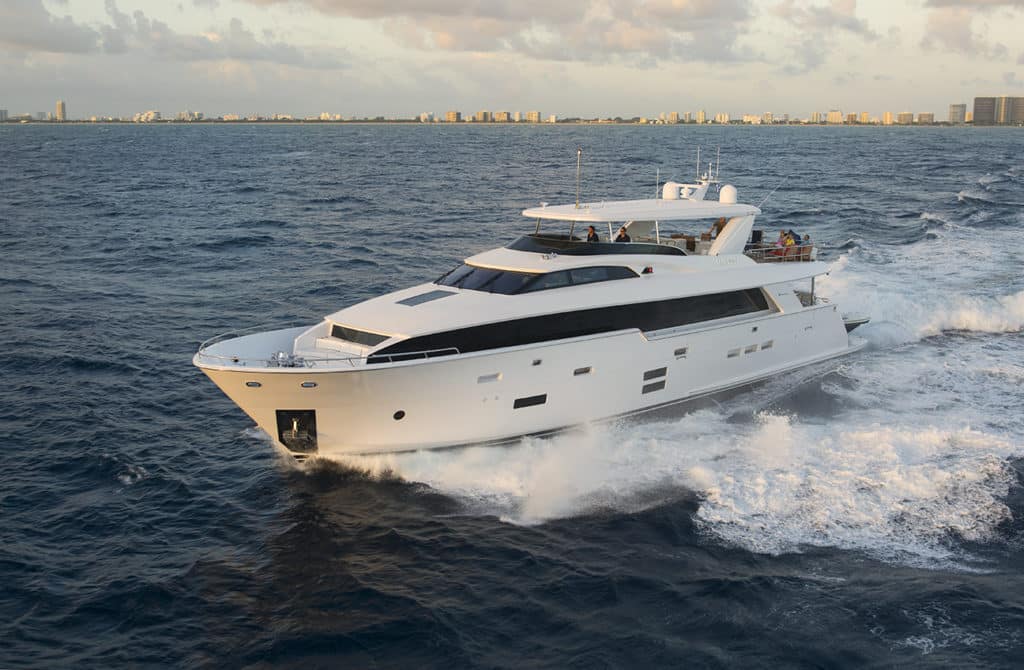
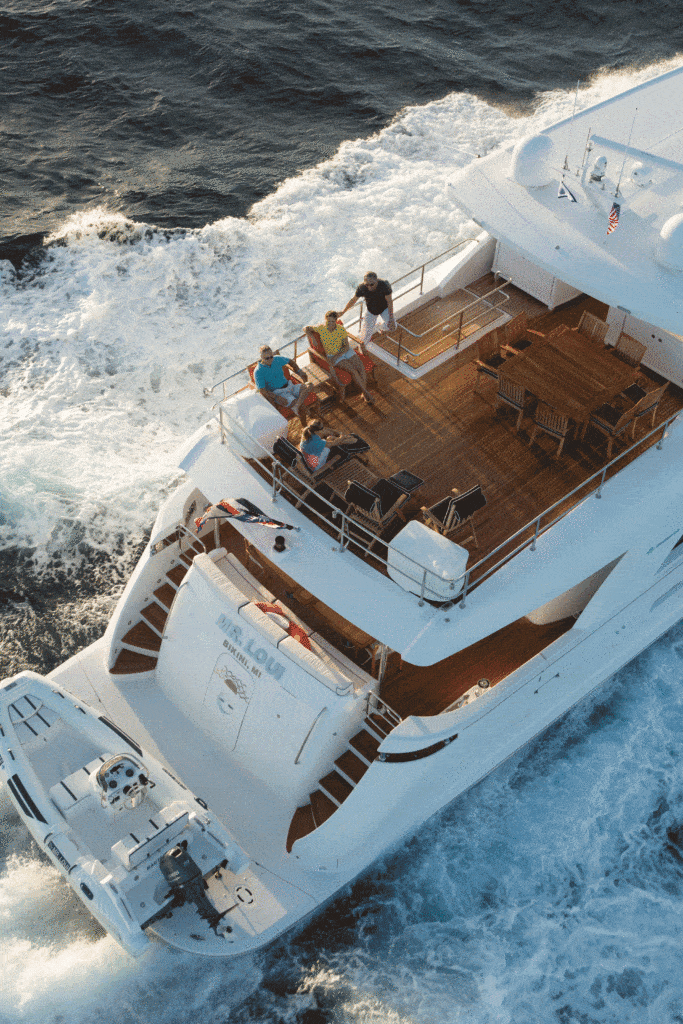
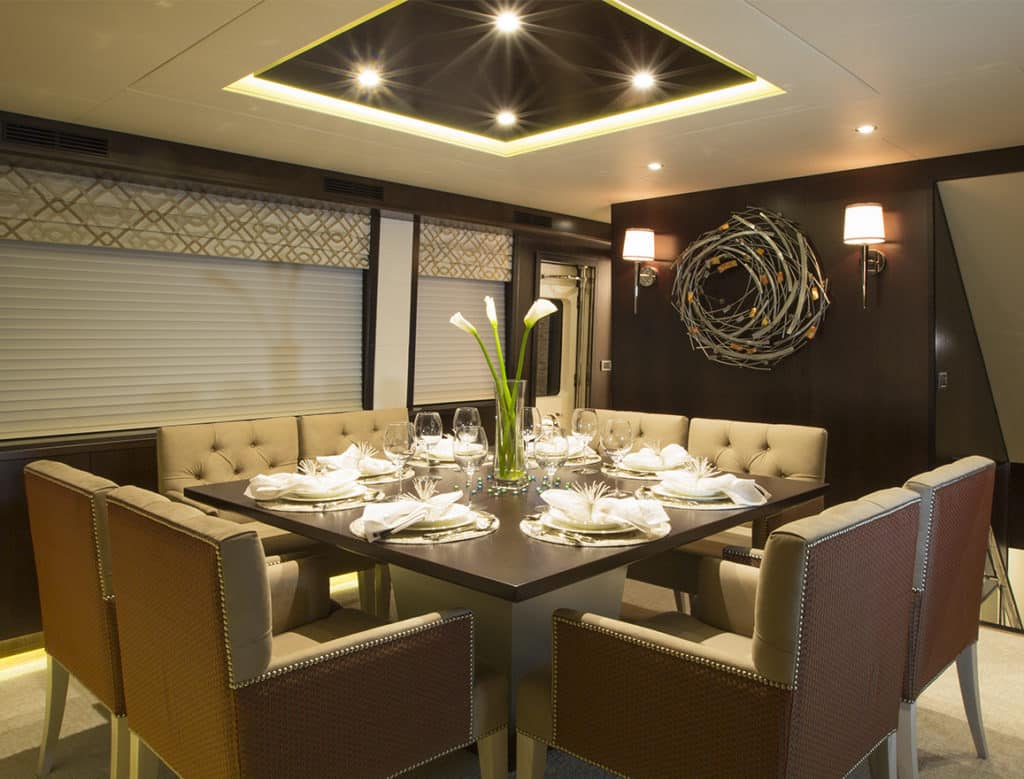
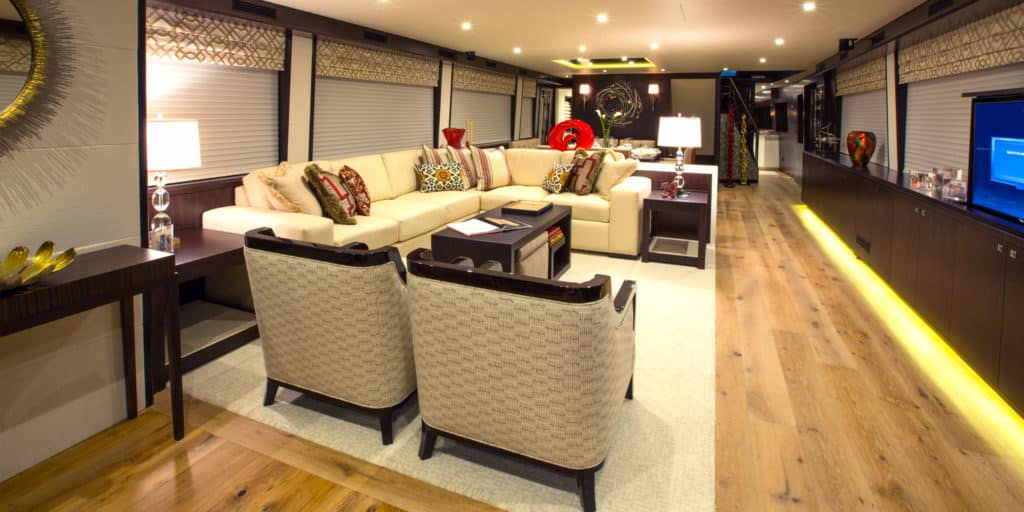
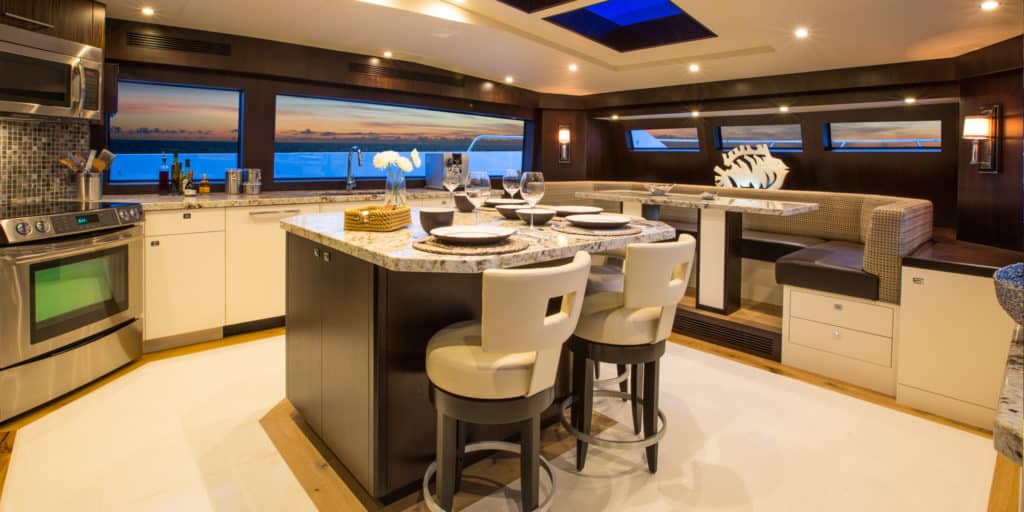
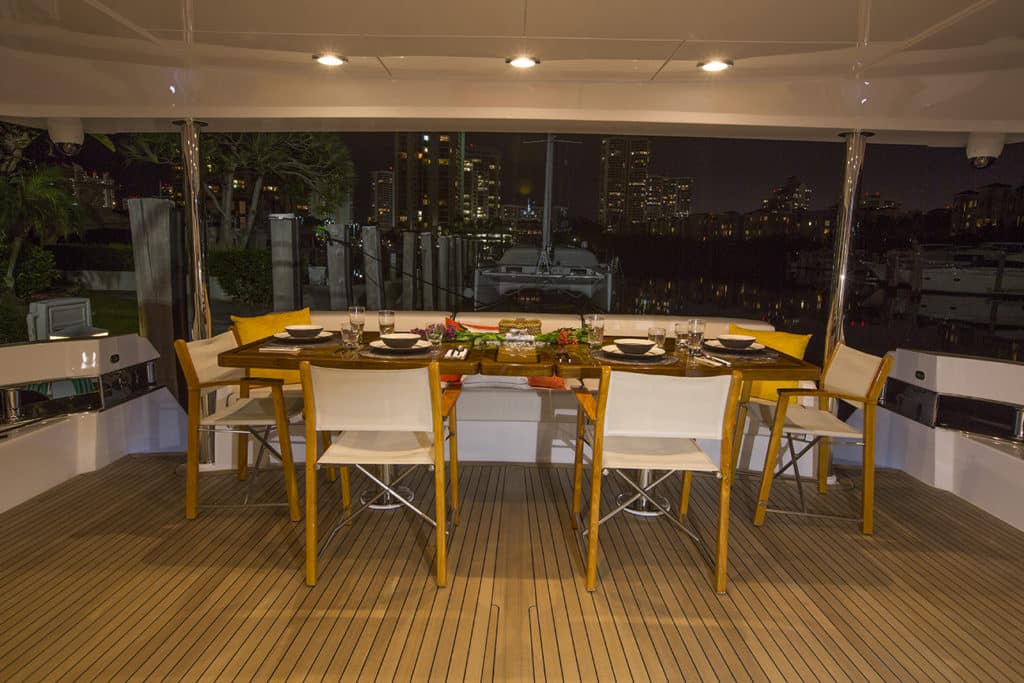
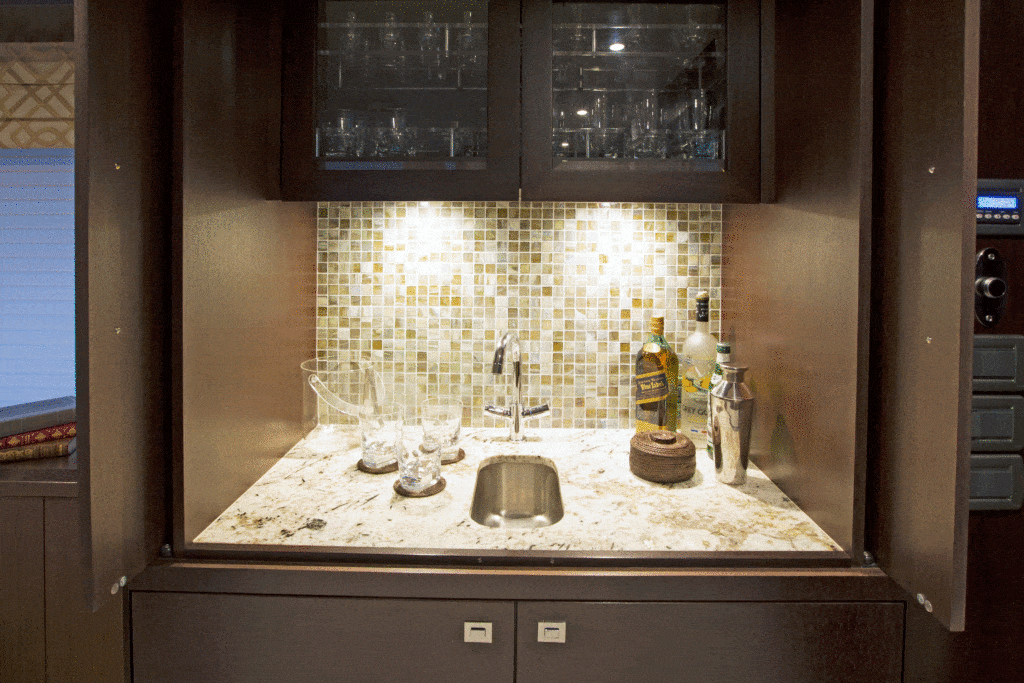
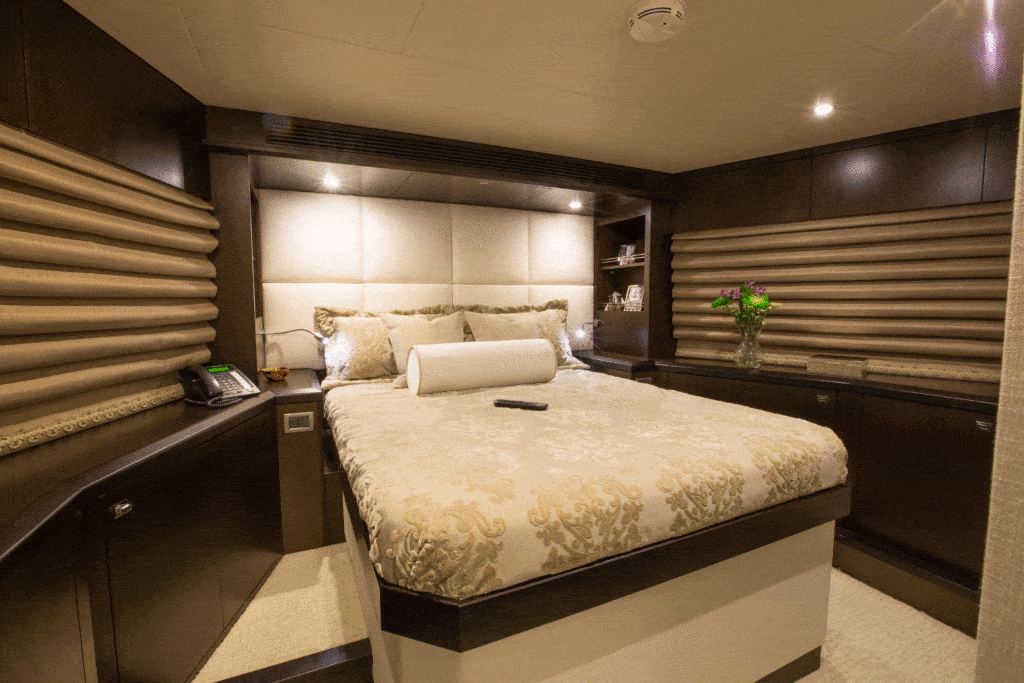
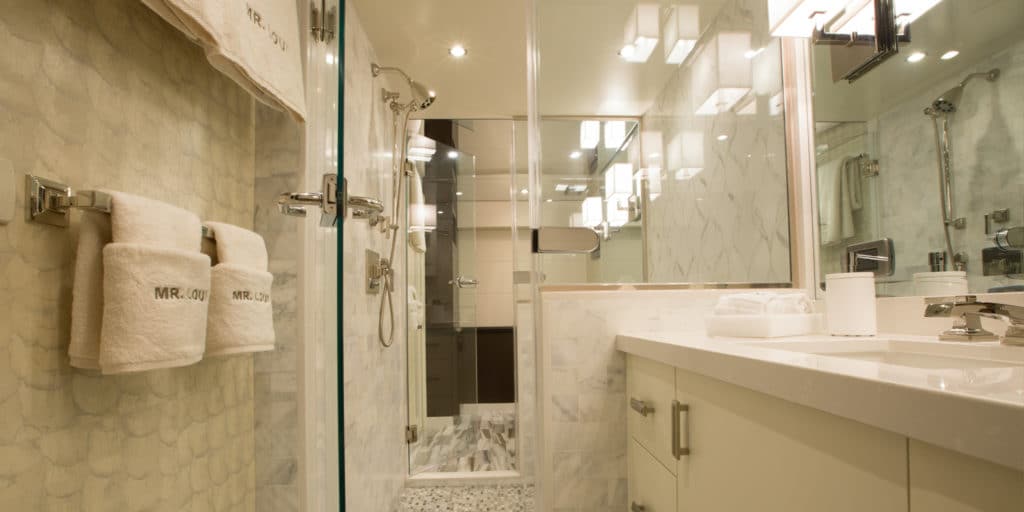
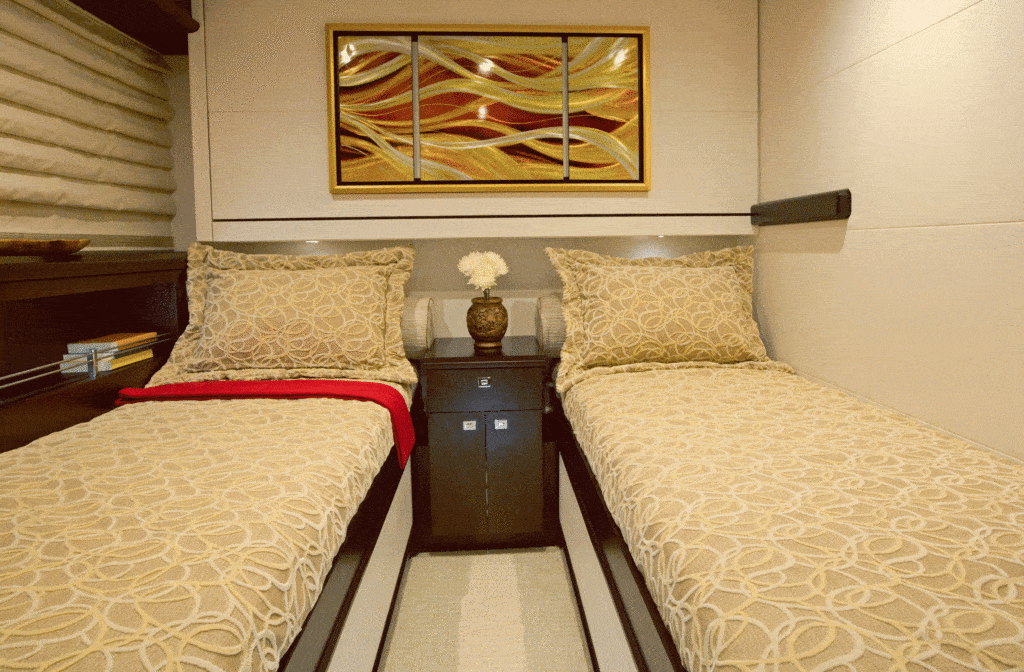
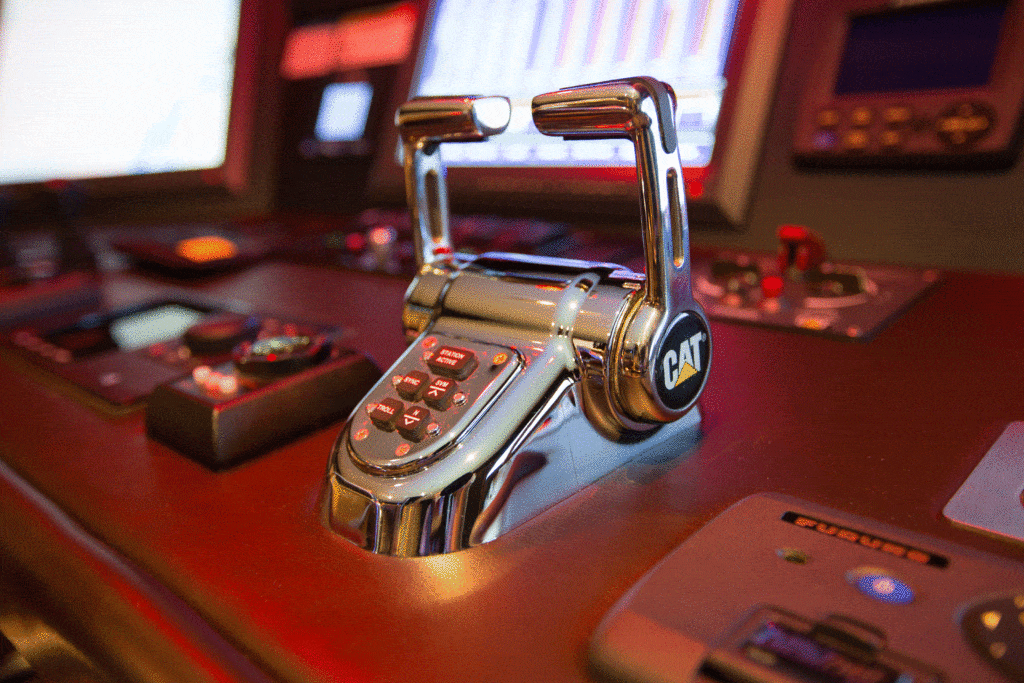
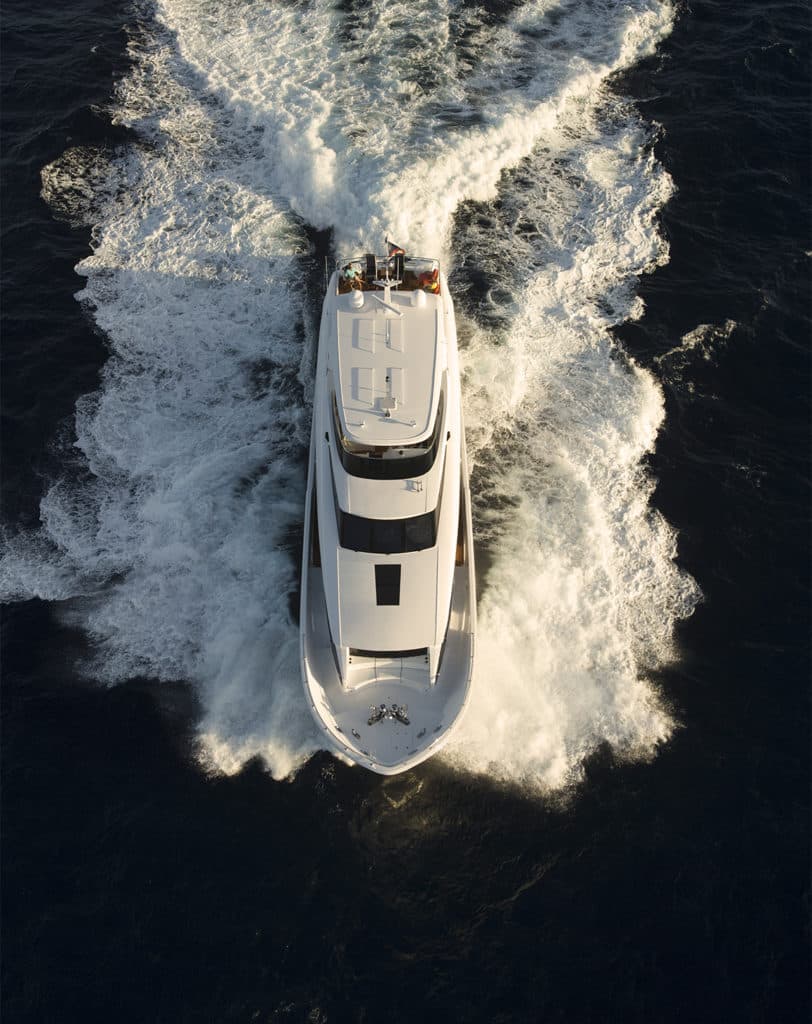
“When they build a bigger Hatteras, I’ll buy it.” Those words came from the owner of Mr. Loui, the builder’s first 100 Raised Pilothouse (RP) and the owner’s seventh Hatteras yacht. Clients with that sort of brand preference are a builder’s fondest dream. It’s a level of loyalty that can only be earned.
Just as impressive as the owner’s string of Hatterases (Hatterai?) is that, because this was the first Hatteras 100RP, he bought Mr. Loui based entirely on the pre-build renderings. That’s more than loyalty. That’s trust.
With the 100RP, however, Hatteras faced a challenge beyond maintaining the trust of a loyal customer. At a length of 100 feet, it was moving out of the owner-operator market that has been a fertile arena for Hatteras motoryachts and convertibles. The builder also faced fleets of challengers from Europe and Asia. The quandary was how to satisfy current customers, who have a distinct mental picture of what a Hatteras looks like, while appealing to buyers who want a more European-style yacht.
Hatteras achieved both goals after bringing in the Italian naval architecture firm Team for Design, whose CEO, Enrico Gobbi, has serious chops with builders like Oceanco and Regal Marine.
The starting point was the previous Hatteras 100 hull, a proven and seakindly design by Jack Hargrave. On this, Gobbi penned exterior lines that lowered the sheer but kept Hatteras traditions such as the widely flared bow and the double chines that throw spray flat to the sides. He added oversize ports in the hull — ports that are now square rather than the lozenge shapes found on the builder’s relatively smaller motoryachts — and a window line that seems to stretch seamlessly from bow to stern.
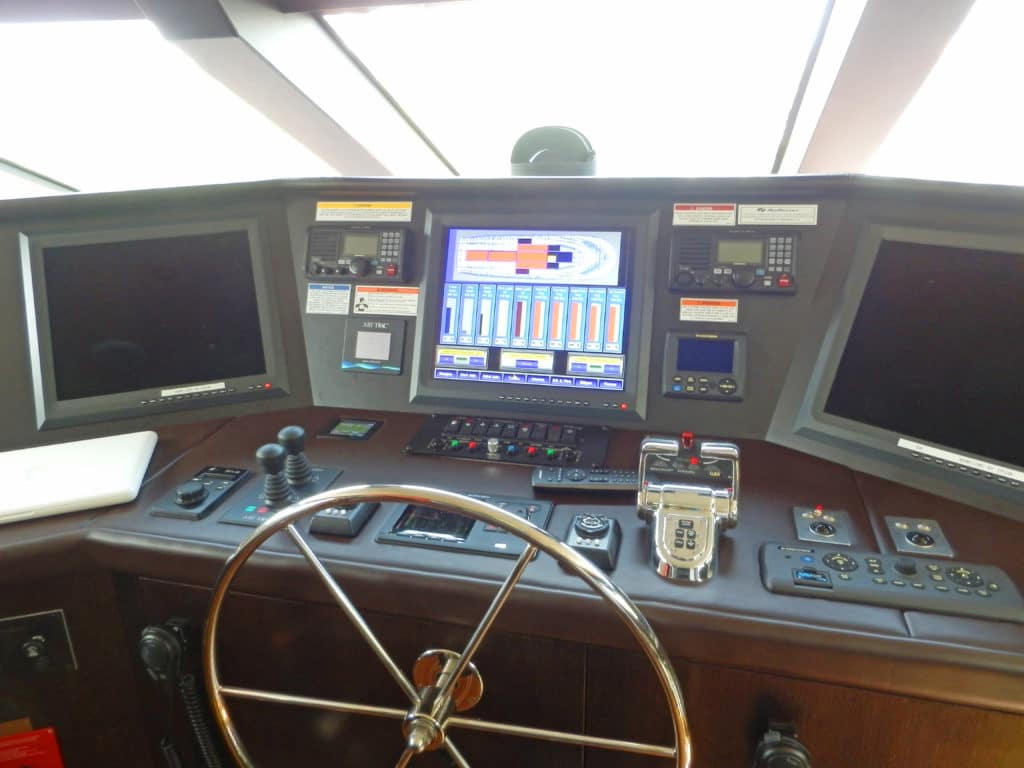
When it came to the interior of Mr. Loui, Hatteras called on Nora Gugel, whose Fort Lauderdale-based A La Mer design firm worked outside the usual Hatteras box. For starters, the soles in the salon and forward galley are light oak, complete with knots, a refreshing change from the usual bulkhead-to-bulkhead carpeting. Area carpeting is under the salon seating, of course, but the planking makes for easy cleanups of galley spills and the uh-ohs from the many youngsters in the owner’s extended family.
Gugel’s design objective, she says, was “to evoke a calmness aboard,” and she used wenge and -ebony furniture and paneling along with neutral, earth-tone upholstery to hit the mark. Accents in bright red that include both artwork and pillows provide cheerful highlights.
In the salon, those long windows Gobbi drew became oversize picture windows with extra spacing between mullions for panoramic views. With nearly 7 feet of headroom, the salon is open, airy and, yes, calming.
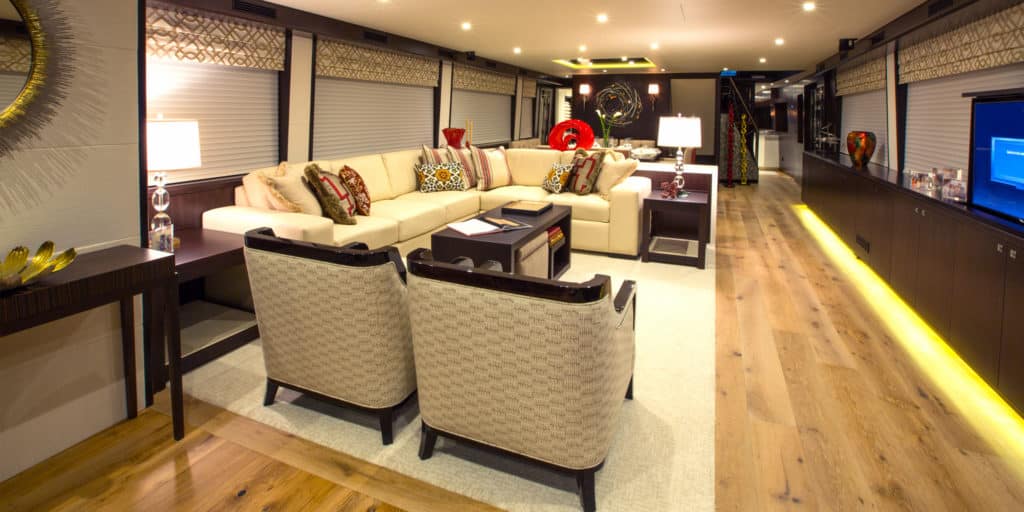
At the forward end of the salon, separated only by a low cabinet to preserve the visual space, is a square table for eight (which is the number Mr. Loui accommodates). I love square tables because they create a more intimate dining atmosphere than those long boardroom styles found on many yachts. Looking around the salon, I kept thinking something was missing, and then I realized: no bar. Most yachts of this size have a stand-behind bar in one corner, usually aft, but Mr. Loui has only cabinets on the starboard side and furniture to port. It turns out the bar actually is aft to starboard, but it’s a walk-up version like you might have at home. The deciding factor there was that stand-behind bars take up too much space, and this solution does the job nicely.
Forward on the main deck is a country-kitchen–style galley reached via a passageway to starboard that also has stainless-steel double doors to the side deck boarding area for welcoming guests when moored alongside. The pilothouse stairs lead from this passage too. Her galley is designed to be welcoming, and it’s exactly that: A banquette handles casual diners as well as loungers to keep the chef company. Bar chairs around a center island are perfect for breakfast or lunch.
Jenn-Air is the appliance of choice, with acres of marble counter leading from the -corner-mounted cooktop and ovens. Particularly notable is the double skylight above the galley, glazed with SPD-SmartGlass that can be electrically dimmed from clear to opaque. This not only reduces midday heat in the galley but, at night, prevents light from the galley skylights from interfering at either helm.
Mr. Loui has the standard galley-forward arrangement, but that area can also become an on-deck master suite, which pushes the galley into an L-shape off the dining area.
Lower-deck layouts can also have the crew cabins aft, or they can be moved forward to create space for a tender garage. In this case, the two crew cabins are aft and the tender is carried on a hydraulic transom platform. These days, many owners are choosing the simplicity of chocking the tenders aft or towing larger tenders. Either way, the crew on Mr. Loui have two double cabins and two private heads with a large shared shower. There is also a comfortable mess area with settee, mini galley and entertainment systems.
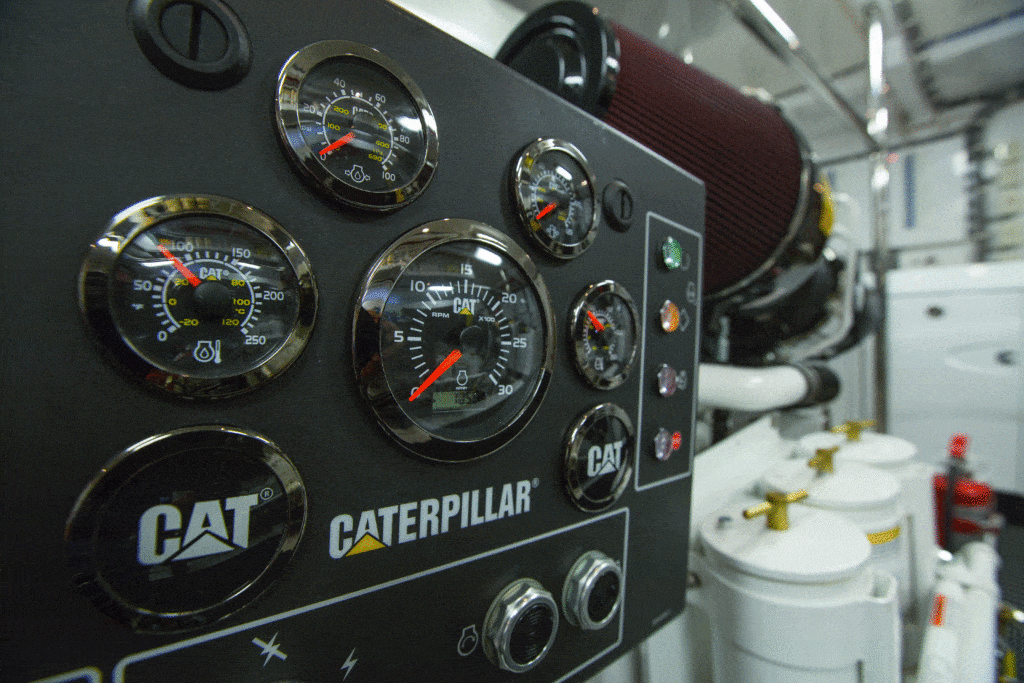
One interesting design option is to have access to all the cabins from the dining area of the salon, rather than having the forward VIP reached from stairs in the galley, as it is on Mr. Loui. Her VIP is at the end of the passageway forward, with a walk-around island berth. The mattress tilts up on gas lifts to reveal large cedar-lined stowage for bulky items like suitcases or golf clubs. Her full-beam master suite has a centerline berth with that same gas-lift feature, plus bureaus on each side under the large windows. His-and-hers heads are just aft, each with a large walk-in closet, and a tiled shower with seat separates the two heads.
In between the VIP and master are two twin staterooms, one on each side of the passageway. In addition to the berths are fore and aft pullman berths to up Mr. Loui’s capacity to 10. Each cabin has an en suite head, with a deep bathtub in the starboard cabin and a large shower in the port. The central passage hides a full-size washer and dryer, and another set lurks in the crew quarters.
Her pilothouse is a bit of a bunker with narrow, steeply slanted windows, but a beautifully arranged helm with a trio of KEP monitors (plus the Hatteras Monitoring System display) that handle a mix of Furuno NavNet and Simrad electronics. The yacht has ABT-TRAC zero-speed stabilizers as well as ABT bow and stern thrusters. A settee in the pilothouse has a marble table, and in a thoughtful touch, the dead area under the seat has file drawers for manuals and papers. Under the pilothouse is an air-conditioned electronics space, with all the black boxes and cables neatly arranged for easy service.
The flybridge is startling for its sheer size, with access by curving stairs from the afterdeck or steps from the pilothouse. It reaches to the transom, and a fiberglass hardtop with electronics arch shades more than half of it. That hardtop also provides a visual separation of the forward entertainment area and the aft open space.
Under the hardtop is the forward helm plus a double companion seat to starboard, and much of the furniture is modular, so Hatteras can -arrange it to fit an owner’s needs. In this case, there is a stand-behind marble–topped bar with four seats, an outdoor kitchen with a double Kenyon grill, a freezer and a settee to starboard with split cocktail tables. Abaft the hardtop, the teak deck is open with room for lounge chairs, chaises and an alfresco dining table for eight.
Two power options are available: a pair of 1,900-horsepower Caterpillar C32A diesels or twin 2,600-horsepower MTU 16V 2000 CRs that up the top speed from about 25 knots to north of 27 knots.
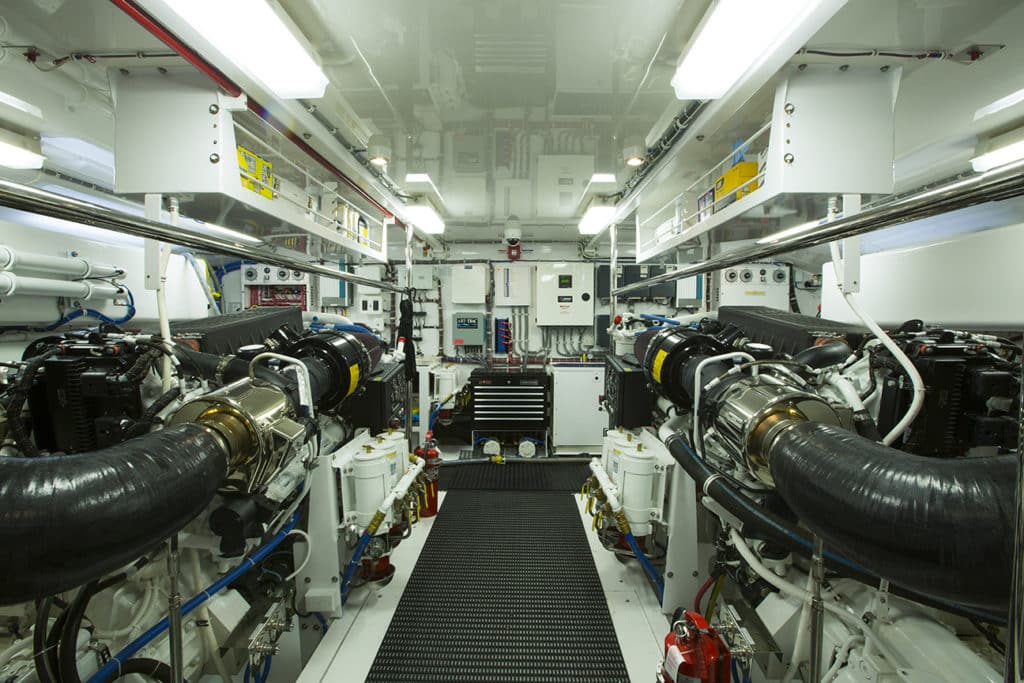
The engine room is large, bright and arranged to make an engineer’s heart go pitter-pat. Mr. Loui has the standard Cat C32s, and they are more than 5 feet apart, leaving a wide promenade between them that is well protected by chrome grab rails for safety at sea. Over each main, and using space that is often just empty air on most yachts, is a pair of long lockers to hold spares and supplies.
The engine room is where you need to spend some time to truly appreciate the exceptional build quality. Take a look at the wiring runs, and you’ll see neatly bundled and color-coded looms carefully seized with wire ties and then, every few inches, secured with padded clamps. Don’t miss the fuel-transfer system that runs between the four primary tanks and the day tank. You’ll find serious filtration (triplex Racors), but look further: Even the fuel-transfer pump has a trio of Racors.
Peek under the engines and you’ll see a fully gelcoated bilge that not only gleams but is also easy to clean if there’s even a drop of oil. Speaking of gelcoat, the Hatteras 100RP has a resin-infused hull that is solid fiberglass underwater and cored with foam in the topsides, so there is no chance of rot.
Her twin diesels, turning through a low 4.7:1 transmission, are spinning 54-by-80 Michigan wheels with eight skewed blades, and these are nearly a third buried in prop tunnels. The result is flat prop-shaft angles, better performance and a Bahamas-friendly draft of 6 feet 2 inches. And here’s another neat thing: Hatteras put old–fashioned Plimsoll marks on the stern so the crew can see what fuel transfers are doing to the draft, especially important in skinny water.
Hatteras walked the tightrope between its classic styling and modern trends with this yacht, and the result is quite an accomplishment. Beautifully built with solid American craftsmanship and arranged sensibly for large families, the Hatteras 100RP will appeal to owners across all oceans.
Always on Watch
Catching my eye in Mr. Loui‘s pilothouse was the Hatteras Monitoring System, displayed on a central monitor directly in the skipper’s line of sight. This state-of-the-art, computerized vessel-monitoring system designed by Hatteras’ electrical engineering team can display a multitude of critical readings, alarms and diagnostic tools, in an easily understood format. The main-engine readings draw from the Caterpillar electronics to display gauges and monitors in ways not available to analog instruments, while the generators have both monitoring and diagnostic capabilities. In addition to vital engine measurements, the system also watches tank levels, bilge pump status and a display of alarms including bilges, carbon monoxide detectors, smoke detectors, engine-room fire, fire-extinguishing system discharge, exhaust temperatures, AC and DC power status and even aft door ajar. Since the monitors are touch screens, many of the systems aboard can be controlled from the helm. In addition to the sunlight-readable, 17-inch, touch-screen monitor in the pilothouse, a 19-inch one is on the bridge and a 15-inch monitor is in the crew quarters. Additional touch screens can be added to fit a client or captain’s needs, as well as added monitoring points. All of the systems have a double disk backup. A history log is maintained, and trends can be set to view various measurements over a period of time. Neatly organized into pages for each operational function, the Hatteras Monitoring System is not just an invaluable tool for captains, but also a useful record for future buyers








